The Aesthetics and Functionality of a White Bath
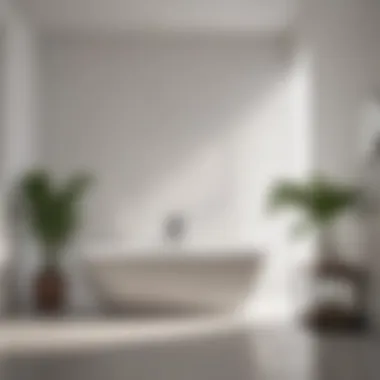
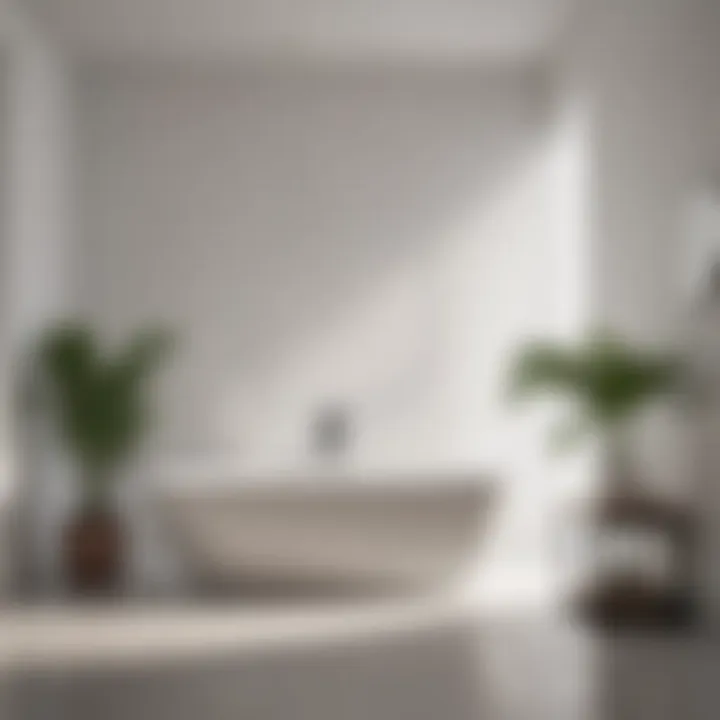
Intro
In recent years, the concept of a white bath has gained significant attention within the realm of interior design. This trend blends aesthetic elegance with practicality, offering a serene atmosphere in which homeowners can unwind. The appeal of a white bathing space lies not only in its visual simplicity but also in its versatility. The use of white allows for various design elements to shine while creating a cohesive and calming environment.
A white bath symbolizes purity, cleanliness, and tranquility, which are essential qualities in a space dedicated to relaxation. This article delves into the intricacies of designing a white bath, exploring historical influences, material choices, lighting considerations, and the potential psychological impacts of such environments. By understanding these elements, homeowners and design enthusiasts can curate a bathing experience that seamlessly integrates beauty with functionality.
Prologue to White Baths
The concept of a white bath has increasingly garnered attention due to its blend of elegance and practicality. Homeowners and interior design enthusiasts alike have found that such spaces promote a sense of calm and serenity. In this article, we explore the design considerations surrounding white baths, highlighting key aspects including aesthetic appeal, material choices, and functionality. It is essential to understand how these elements influence modern interior design, transforming a simple bathing area into a cohesive part of the home.
Defining a White Bath
A white bath typically refers to a spaces where white dominates the color scheme. This includes not just the walls and tiles, but often fixtures, cabinetry, and accessories as well. White's versatility allows it to adapt to various design styles, from minimalist to traditional. The choice of white can evoke cleanliness and freshness, contributing to a relaxing atmosphere. However, the effectiveness of a white bath also hinges on the careful selection of materials and finishes. Matte, glossy, and textured elements each impart their own character to the space, fundamentally influencing how the environment feels.
Historical Context and Evolution
Historically, the integration of white in bathing spaces can be traced to classical styles, where it signified purity and opulence. This trend evolved through various movements, reflecting cultural values and technological advancements in design and materials. For instance, during the Victorian era, the rise of porcelain fixtures marked a shift towards more sophisticated white baths. As society moved into the 20th century, the aesthetic momentum continued with mid-century modern designs emphasizing sleek lines and open-space concepts. Today, contemporary white baths reflect minimalism's enduring influence, showcasing clean designs and functional layouts.
The evolution of white baths encapsulates not just aesthetic preferences but also broader societal shifts toward wellness and personal retreat. Understanding this context enriches our appreciation of what a white bath can offer in today's interiors.
Aesthetic Considerations
Aesthetic considerations are core to any design project, especially in creating a white bath. The use of white not only offers a sense of cleanliness but also fosters an atmosphere of tranquility. This color has the unique ability to make spaces feel open and airy, particularly in typically smaller bathrooms. When planning a white bath, it is essential to explore how different elements interact to create visual balance and harmony.
While white creates a neutral backdrop, the choice of textures and materials adds depth. Therefore, understanding how to blend different shades of white and textures becomes crucial. These elements must work together to ensure the space feels organized and inviting rather than stark and sterile.
Additionally, aesthetic choices have a psychological impact. A well-thought-out white space can evoke feelings of relaxation, making it a perfect retreat. This is essential, especially in spaces designed for personal rejuvenation. Thus, considering aesthetics is not just about beauty; it's about creating an environment that improves quality of life.
Visual Harmony and Balance
Achieving visual harmony in a white bath hinges on the careful arrangement of visual elements. Proportion and placement play an essential role in maintaining a balanced look. Symmetry is one technique that can enhance this equilibrium, making the space feel orderly. Counterbalancing larger features, such as a freestanding tub, with smaller accessories is also effective in achieving harmony.
Factors like light direction also influence how the arrangement appears. A space flooded with natural light will demonstrate balance differently than a dimly lit room. Therefore, assessing the layout and light sources ensures that visual elements align correctly.
Textural Variations in White Design
Matte vs. Glossy Finishes
The distinction between matte and glossy finishes significantly impacts a white bath design. Matte surfaces absorb light, offering a soft, sophisticated feel. This choice can create a calm environment, as it reflects less light than glossy finishes. On the other hand, glossy finishes reflect light, often making spaces feel brighter and more expansive.
Gloss finishes can be illuminating but may require more upkeep to remove smudges and water spots. While some homeowners prefer the sleek look of gloss, others lean towards the subdued elegance of matte. Both choices come down to personal preference and maintenance considerations, making it vital to weigh the functional aspects along with aesthetic appeal.
Patterned Textiles and Accessories
Incorporating patterned textiles and accessories adds an engaging element to a white bath. These pieces introduce color and dimension without overwhelming the backdrop. Patterns can range from subtle geometric designs to bold florals, depending on the desired aesthetic.
The key characteristic of using patterns is their ability to introduce warmth and personality into the space. Also, they can easily be replaced or rotated according to seasonal changes or trends, providing flexibility in design. However, it is crucial to select patterns carefully to avoid a cluttered appearance, ensuring that they complement rather than clash with the overall design of the white bath.
Material Selection
The choice of materials is fundamental to creating a cohesive and functional white bath. Selecting the appropriate materials influences not just the durability and maintenance of the space, but also contributes significantly to the overall aesthetic. This section will delve into the critical elements concerning material selection, focusing on tile and countertop choices, as well as exploring sustainable options.
The use of materials in a white bath sets the tone for elegance and sophistication. Homeowners and designers must consider factors such as texture, color variations, and how these materials interact with light. Different materials can evoke different feelings and styles. For example, a glossy tile can give a more contemporary vibe, while matte surfaces may convey warmth and comfort.
Furthermore, durability is key. White baths require materials that withstand high moisture levels without losing their appearance. Hence, it’s vital to assess how each material performs under such conditions.
Choosing the Right Materials
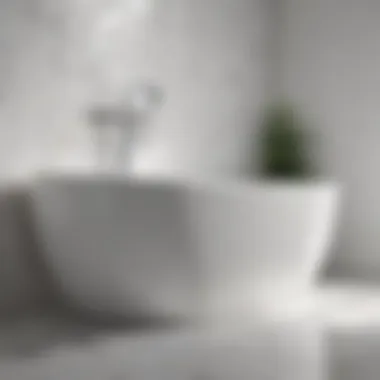
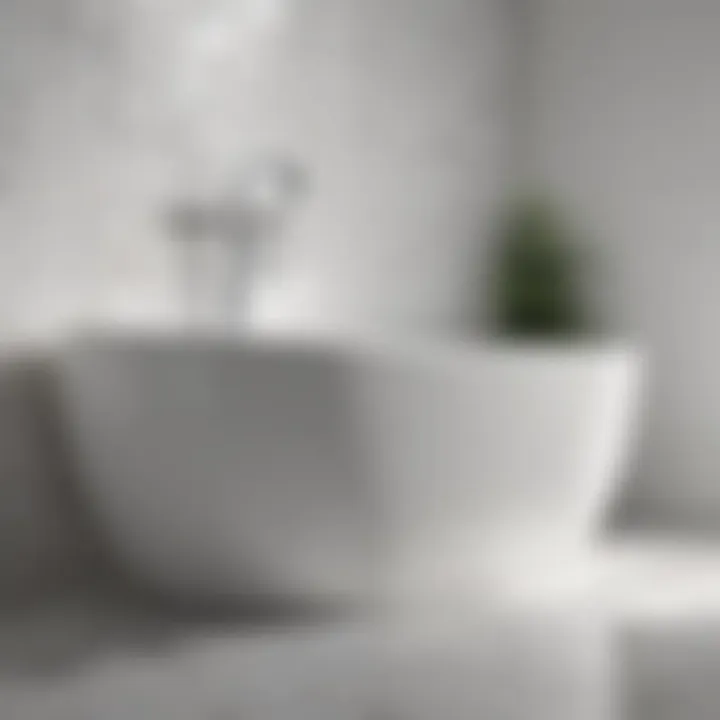
Tiles: Porcelain and Ceramic
Porcelain and ceramic tiles are among the most popular choices for white baths due to their durability and aesthetic appeal. These tiles have a high resistance to moisture and can handle the demanding environment of a bathroom. Their key characteristic is their versatility. They come in numerous finishes and styles, making it easy to find the perfect match for a white bath design.
A unique feature of porcelain is its low porosity. This property makes it less prone to stains and easier to clean compared to ceramic. However, ceramic tiles generally come at a lower price point, offering a budget-friendly option while still presenting an impressive aesthetic.
Advantages of porcelain and ceramic tiles include:
- High durability
- Variety of colors and textures
- Resistance to moisture
Disadvantages include:
- Porcelain can be heavier and require more support for installation
- Some ceramic tiles can be less resilient to heavy impacts, leading to chipping.
Countertops: Stone vs. Solid Surface
When it comes to countertops, stone and solid surface materials offer distinct advantages. Stone counters, such as granite or marble, are favored for their natural beauty and uniqueness. Each slab has different patterns and colors, which add character to a white bath. They’re exceptionally durable as well, standing up remarkably well to heat and scratches.
On the other hand, solid surface materials like Corian offer an entirely customizable experience. They can be molded into shapes and sizes that suit specific design needs, which is a significant advantage when creating seamless installations.
Key characteristics of stone countertops include:
- Unique and varied designs
- High durability
- Natural materials
But there are some disadvantages:
- Stone often requires sealing to prevent stains
- Can be more expensive and require careful maintenance.
Solid surface materials also have benefits:
- Easily repairable
- Non-porous, making them resistant to staining
- Wide range of colors and patterns available
Yet they may present some downsides:
- May be less heat resistant than stone
- Can scratch or dent more easily if not cared for properly.
Sustainable Material Options
Sustainability has grown increasingly significant in material selection for modern white baths. Eco-friendly choices not only minimize environmental impact but can also enhance the aesthetic appeal. Some options include reclaimed wood elements and recycled glass tiles, offering unique textures and colors without harmful effects on the planet.
Using sustainable materials not only reflects a commitment to responsible design but also can create a more inviting space. Each element plays a role in shaping the environment inside the bath, contributing to how one feels when they step into that space.
In summary, material selection is a vital consideration that affects the aesthetics and functionality of a white bath. Placing emphasis on quality, durability, and sustainable options can lead to a successful and harmonious bathing environment.
Lighting Techniques
Lighting in a white bath is not just about visibility; it plays a crucial role in enhancing the overall aesthetics and functionality of the space. The right lighting techniques can elevate the serene appeal of a white bath and significantly impact the mood and usability of the area. Proper integration of natural and artificial lighting ensures that the bathing experience is not only visually pleasing but also practical.
Natural Light Integration
Natural light is one of the best sources of illumination. It can transform a white bath, making it appear more spacious and inviting. Large windows or skylights are effective ways to bring in natural light. When strategically placed, they can maximize daylight, reducing the need for artificial lighting during the day.
Incorporating natural light can improve mental well-being as well. Studies show that exposure to daylight enhances mood and can contribute to feelings of calm. Furthermore, with adequate natural light, the subtle variations in textures and materials used in the space can be appreciated more fully, adding depth to the design.
Artificial Lighting Solutions
When it comes to artificial lighting, versatility is key. There are several layers to consider, including vanity lighting and ambient accents.
Vanity Lighting Options
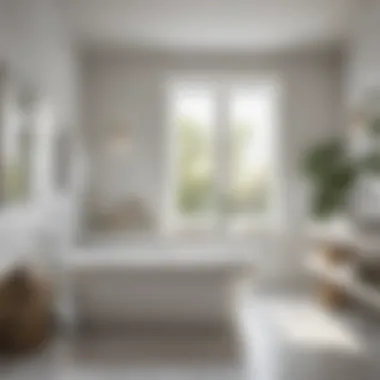
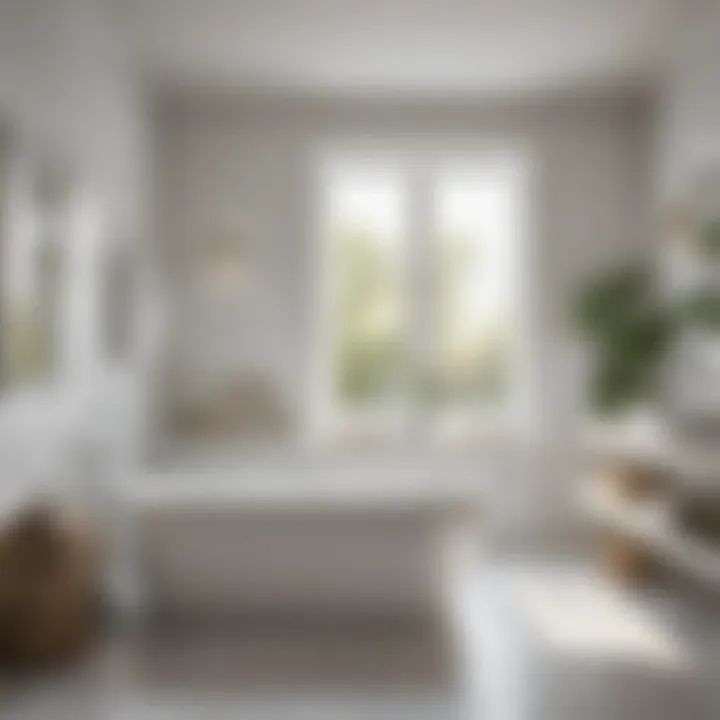
Vanity lighting serves a specific purpose: enhancing visibility for grooming tasks. It is essential to choose fixtures that provide even lighting without harsh shadows. Wall-mounted sconces or backlit mirrors are popular choices in white baths. These types of lights help avoid any distortion while applying makeup or shaving.
A beneficial characteristic of good vanity lighting is the ability to control brightness. Dimmable options allow users to adjust the light according to their needs, making it a popular feature.
A unique feature in some vanity installations is the color temperature adjustment. This offers the ability to switch between warm and cool tones, mimicking natural daylight or creating a relax atmosphere. The drawback is that they might require additional installation effort or higher costs.
Ambient and Accent Lighting
Ambient lighting creates a general illumination that fills the space, while accent lighting adds interest and highlights specific areas. The combination of both can enhance the aesthetic appeal while ensuring functionality.
Ambient lighting typically comes from ceiling fixtures or recessed lights. Its key characteristic is to provide a soft, even glow throughout the room. This type of lighting is beneficial because it creates a warm atmosphere, making the space feel cozy.
Accent lighting is often used to draw attention to architectural features or decor elements, such as art or plants. The distinct advantage of accent lighting is that it can enhance the texture and design of your white bath, adding layers and visual depth. However, too much accent lighting can create an imbalance in the overall design.
Effective lighting design is not merely functional; it is a fundamental element that contributes significantly to the overall atmosphere and usability of a white bath.
Psychological Effects of White Spaces
The design of a white bath goes beyond mere aesthetics; it significantly impacts the psychological well-being of those who use it. The psychology of color suggests that environmental colors can evoke specific emotional responses. White, often associated with purity and cleanliness, provides a unique backdrop for relaxation and rejuvenation. This section explores how white spaces influence emotions and tranquility, making them vital to any bathroom design.
Emotional Responses to Color
Color is a powerful tool in interior design. Research indicates that different colors can elicit varying emotional responses. White, for example, is often linked to a sense of calm and serenity. This response can create an atmosphere where one feels at ease. In a bathroom, which is primarily a sanctuary for personal care, the calming effect of white may enhance the overall experience.
Furthermore, the use of white can amplify natural light. When light reflects off white surfaces, it not only brightens the space but also elevates mood. This natural brightness is important for creating an inviting environment. Strategically incorporating white elements can allow the feeling of openness, crating a sense of tranquility in the daily routine of personal care.
Creating a Calming Environment
A white bath can be designed to promote relaxation and peace. The simplicity of a white palette allows for minimal distractions, inviting occupants to unwind. To achieve this calming environment, various design choices play a role:
- Material Selection: Choosing smooth materials can add to the sense of calm. For example, porcelain tiles or solid surface countertops have cool, clean lines.
- Soft Textiles: Including soft, white towels and bath mats can instill a comforting aspect in the space.
- Lighting: Ambient lighting that is soft and warm can enhance the calming effect of the space.
Incorporating subtle elements like greenery can also create a gentle contrast against white. Adding plants is an effective way to promote a living environment and instill a feeling of freshness.
In summary, the psychological effects of white spaces are significant in shaping an atmosphere meant for relaxation. Homeowners and designers should consider these factors as they create a white bath, ensuring the design promotes a sanctuary where one can truly refresh.
Styling and Accessorizing
Styling and accessorizing play a crucial role in creating an inviting and functional white bath. While a white bath is often appreciated for its clean and minimalist appeal, it can sometimes feel sterile or cold without the right touches. Incorporating thoughtful design elements can enhance aesthetics and improve functionality. The right accessories can bring warmth, character, and life to the space. It is essential to choose items that not only complement the white backdrop but also serve practical purposes.
Incorporating Color Accents
Accents of color are vital to break the monochrome feel of a white bath. This can be done through various means, such as using colorful towels, decorative trays, or even wall art. Soft hues, like pastel shades, can introduce a sense of calmness, while brighter colors can add personality and vibrancy.
Utilizing color thoughtfully helps to create focal points. For example, a bold-colored bath mat can become a centerpiece, drawing the eye and providing contrast. When selecting color accents, consider the overall theme and desired atmosphere for the bath. Matching colors can create a sense of cohesion, while contrasting colors can give a more eclectic or modern feel.
Selecting Functional Accessories
Storage Solutions
Storage solutions are a key component in maintaining order and enhancing the usability of a white bath. Functionality is essential, especially in smaller spaces where clutter can quickly accumulate. Selecting the right storage options helps to keep necessities organized and accessible. Popular choices include wall-mounted shelves, under-sink cabinets, and decorative baskets.
One significant characteristic of effective storage solutions is their dual functionality. For instance, open shelves can provide storage while also serving as a display place for aesthetically pleasing items like plants or decorative jars. This balance of form and function makes storage solutions not just practical but also visually appealing, which is a beneficial feature in white baths.
The unique feature of storage solutions in this context is versatility. Many options can suit various styles, from modern to rustic. However, a potential disadvantage could be maintenance. Open shelving may require more frequent cleaning to keep dust and clutter at bay than enclosed cabinets.
Decorative Elements
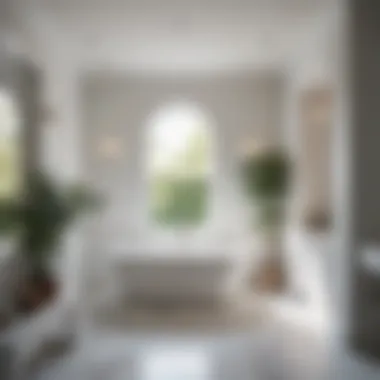
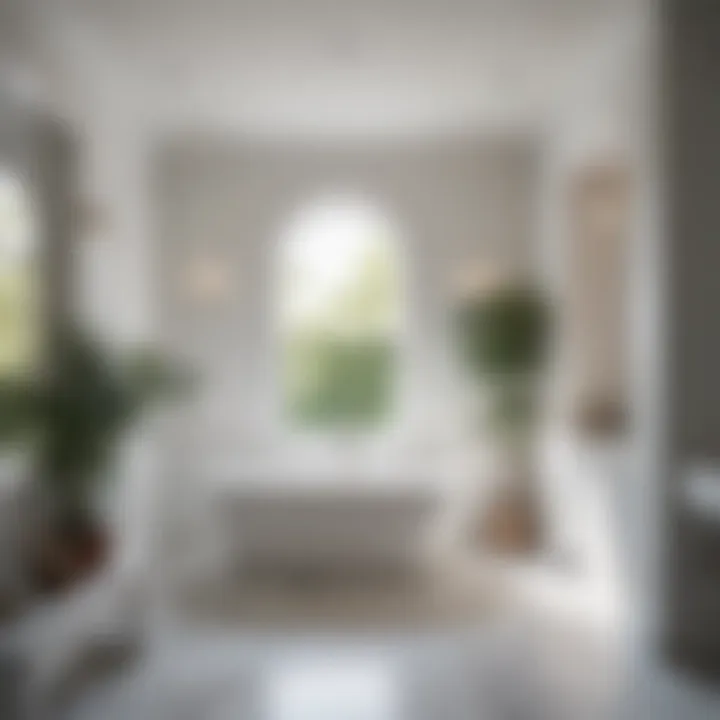
Decorative elements can significantly enhance the charm of a white bath. Rather than merely functional, these items contribute to the overall aesthetic and atmosphere. Decorative items might include framed art, stylish soap dispensers, scented candles, or lush plants.
A notable trait of these elements is their ability to add character without overwhelming the space. For example, a single vibrant painting can break the monotony of white, providing a visual anchor. This characteristic makes decorative elements a popular choice for elevating the design of white baths.
The unique feature of decorative elements lies in their capacity for personalization. Homeowners can express their tastes and preferences through careful selection. On the downside, too many decorative items can lead to visual clutter, which can be a consideration in the design process. Therefore, careful curation is essential to keep a balanced and serene environment.
Maintenance and Cleaning
Maintaining a white bath is essential for preserving its aesthetic appeal. White surfaces can be forgiving but also reveal dirt, stains, and wear more clearly than darker finishes. Regular maintenance ensures that the tranquil feel of a white bath can be enjoyed without disruption. A clean, white environment positively affects the overall atmosphere, making it feel fresh and inviting.
Best Practices for White Baths
To keep your white bath looking its best, consider the following best practices:
- Routine Cleaning: Establish a regular cleaning schedule. This may include daily quick cleans and deeper weekly scrubs.
- Use Non-Abrasive Cleaners: Choose gentle cleaners to avoid scratching surfaces. Vinegar and baking soda solutions can effectively tackle grime without damaging finishes.
- Microfiber Cloths: Use microfiber cloths for drying and polishing. They help avoid streaks on glossy surfaces while picking up dirt effectively.
- Ventilation: Proper ventilation prevents mold and mildew, especially in areas with high humidity. Consider installing an exhaust fan or opening windows after showers.
Following these practices can help maintain the brightness and clarity of your white bath, prolonging the life of your materials and enhancing the serenity of the space.
Addressing Stains and Discoloration
Stains and discoloration are challenges inherent to white baths. Prompt attention to these issues can prevent them from becoming permanent. Here's how to address common stains:
- Water Stains: Wipe down taps and shower areas regularly to prevent mineral buildup. Using a squeegee after use can minimize streaks.
- Soap Scum: To combat soap scum, use a mixture of vinegar and dish soap. Apply it to the affected areas, allowing it to sit briefly before scrubbing.
- Hard Water Stains: For stubborn hard water spots, try a paste of baking soda and vinegar. Apply, let it sit, and wipe clean for effective removal.
- Discoloration from Products: Some bath products can lead to staining. Always test new products on a small, unseen area before widespread use.
Keeping white bath spaces pristine may require consistent effort, but the rewards are significant. A clean and bright bathroom provides a welcoming and calming environment that reflects well on your home.
By proactively addressing maintenance and stains, homeowners can ensure their white bath remains an oasis of calm and beauty.
Combining White with Other Colors
In interior design, white often acts as a neutral backdrop that enhances other colors. Combining white with other hues can lead to a visually appealing and harmonious ambiance. This section examines two primary approaches: integrating neutral palettes and creating bold color contrasts. Understanding these elements allows homeowners and design enthusiasts to elevate the aesthetic and functionality of their white baths.
Neutral Palettes
Utilizing a neutral palette alongside white adds depth without overwhelming the space. Shades like beige, gray, and taupe work well, as they maintain the serene vibe associated with white baths. Moreover, this strategy creates a subtle layering effect, enhancing dimensionality while promoting balance.
A few key benefits of selecting neutral palettes include:
- Timeless Appeal: Neutral colors have longevity in design trends, ensuring that your choices remain stylish and relevant.
- Flexibility: A neutral palette allows for easy updates. Changing a few accessories can transform the overall look without significant renovation.
- Focus on Texture: Using varied textures can help differentiate between elements, making the space visually engaging. Consider incorporating textiles like soft towels or woven baskets in neutral tones.
Bold Color Contrasts
In contrast, bold color combinations can make a powerful statement within a white bath. Using vibrant colors like navy blue or emerald green can create exciting focal points. When strategically placed, these colors draw the eye to specific areas, adding visual interest and energy to the space.
Some considerations for using bold colors include:
- Accent Walls: Painting one wall in a bold hue can create drama and enhance the overall design. This can be especially effective in smaller baths, where a splash of color will not overpower.
- Dynamic Accessories: Incorporate accessories like towels, rugs, or decorative items in bold colors. These elements are easy to change and can bring a fresh look to the bath.
- Color Psychology: Different colors elicit various emotional responses. For instance, deep blues can evoke calmness, while vivid reds may incite energy. Consider the desired mood when integrating these colors.
In summary, combining white with other colors provides opportunities to enhance both aesthetics and functionality of a bath. By balancing neutral palettes with bold suspensions, a beautiful space can be created that reflects personal taste and creates a welcoming environment.
This thoughtful approach to color can significantly increase enjoyment and satisfaction in one's bathing retreat.
The End
The consideration of a white bath design is not merely an aesthetic choice; it holds significant value in both functionality and emotional well-being. This article has delved into various aspects of creating a white bath that is both practical and visually pleasing. By understanding the interplay between materials, lighting, and styling elements, homeowners can create a serene sanctuary that reflects their lifestyle.
One key element highlighted is the versatility of a white palette. White acts as a canvas that allows for creativity in integrating various textures and colors, enhancing the overall ambiance of the space. The careful selection of materials, such as porcelain tiles and stone countertops, not only contributes to the visual harmony but also ensures durability and ease of maintenance.
Lighting plays a crucial role in elevating the aesthetic appeal of a white bath. Natural light can make a white space feel larger and more inviting, while artificial lighting solutions can accentuate features and create desired moods. Understanding how different lighting techniques work can greatly impact the overall experience of the bath area.
Moreover, the psychological implications of a white environment contribute to a sense of calm and relaxation. The color white is often associated with purity and cleanliness. Thus, incorporating it into bath design can lead to a more tranquil environment, which is essential for the rituals of cleansing and self-care.
By thoughtfully combining color accents and considering functionality in accessories, homeowners can enhance both the beauty and practicality of their white bath spaces. Careful attention to maintenance and cleaning can mitigate potential issues associated with the use of a predominantly white color scheme, ensuring the space remains pristine and inviting for years.
In summary, the successful design of a white bath requires an understanding of its multifaceted nature. It is not only about visual appeal; it is about creating a harmonious balance between aesthetics and functionality that serves the needs of the user. This comprehensive exploration guides discerning homeowners toward achieving a refined and peaceful bathing experience.















